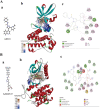Novel venom-based peptides (P13 and its derivative-M6) to maintain self-renewal of human embryonic stem cells by activating FGF and TGFβ signaling pathways
- PMID: 32552810
- PMCID: PMC7302175
- DOI: 10.1186/s13287-020-01766-9
Novel venom-based peptides (P13 and its derivative-M6) to maintain self-renewal of human embryonic stem cells by activating FGF and TGFβ signaling pathways
Abstract
Background: In our previous study, a venom-based peptide named Gonearrestide (also named P13) was identified and demonstrated with an effective inhibition in the proliferation of colon cancer cells. In this study, we explored if P13 and its potent mutant M6 could promote the proliferation of human embryonic stem cells and even maintain their self-renewal.
Methods: The structure-function relationship analysis on P13 and its potent mutant M6 were explored from the molecular mechanism of corresponding receptor activation by a series of inhibitor assay plus molecular and dynamics simulation studies.
Results: An interesting phenomenon is that P13 (and its potent mutant M6), an 18AA short peptide, can activate both FGF and TGFβ signaling pathways. We demonstrated that the underlying molecular mechanisms of P13 and M6 could cooperate with proteoglycans to complete the "dimerization" of FGFR and TGFβ receptors.
Conclusions: Taken together, this study is the first research finding on a venom-based peptide that works on the FGF and TGF-β signaling pathways to maintain the self-renewal of hESCs.
Keywords: Embryonic stem cell; Peptide modification; Pluripotency; Self-renewal; Venom peptide.
Conflict of interest statement
The authors declare no conflict of interest.
Figures









Similar articles
-
Dissecting signaling pathways that govern self-renewal of rabbit embryonic stem cells.J Biol Chem. 2008 Dec 19;283(51):35929-40. doi: 10.1074/jbc.M804091200. Epub 2008 Oct 20. J Biol Chem. 2008. PMID: 18940811
-
Activin A maintains self-renewal and regulates fibroblast growth factor, Wnt, and bone morphogenic protein pathways in human embryonic stem cells.Stem Cells. 2006 Jun;24(6):1476-86. doi: 10.1634/stemcells.2005-0299. Epub 2006 Feb 2. Stem Cells. 2006. PMID: 16456129
-
[Expression of TGFbeta family factors and FGF2 in mouse and human embryonic stem cells maintained in different culture systems].Ontogenez. 2013 Jan-Feb;44(1):10-23. doi: 10.7868/s0475145013010060. Ontogenez. 2013. PMID: 23659078 Russian.
-
A molecular basis for human embryonic stem cell pluripotency.Stem Cell Rev. 2005;1(2):111-8. doi: 10.1385/SCR:1:2:111. Stem Cell Rev. 2005. PMID: 17142845 Review.
-
In or out stemness: comparing growth factor signalling in mouse embryonic stem cells and primordial germ cells.Curr Stem Cell Res Ther. 2009 May;4(2):87-97. doi: 10.2174/157488809788167391. Curr Stem Cell Res Ther. 2009. PMID: 19442193 Review.
Cited by
-
Human embryonic stem cells cultured on hydrogels grafted with extracellular matrix protein-derived peptides with polyethylene glycol joint nanosegments.IET Nanobiotechnol. 2022 Dec;16(9):295-304. doi: 10.1049/nbt2.12091. Epub 2022 Oct 6. IET Nanobiotechnol. 2022. PMID: 36200801 Free PMC article.
-
Peptide Conjugate on Multilayer Graphene Oxide Film for the Osteogenic Differentiation of Human Wharton's Jelly-Derived Mesenchymal Stem Cells.Polymers (Basel). 2021 Sep 26;13(19):3290. doi: 10.3390/polym13193290. Polymers (Basel). 2021. PMID: 34641106 Free PMC article.
References
-
- King GF. Venoms as a platform for human drugs: translating toxins into therapeutics. Expert Opin Biol Ther. 2011;11(11):1469–1484. - PubMed
-
- King GF, Escoubas P, Nicholson GM. Peptide toxins that selectively target insect Na-V and Ca-V channels. Channels. 2008;2(2):100–116. - PubMed
-
- de la Vega RC R, Possani LD. Overview of scorpion toxins specific for Na+ channels and related peptides: biodiversity, structure-function relationships and evolution. Toxicon. 2005;46(8):831–844. - PubMed
Publication types
MeSH terms
Substances
LinkOut - more resources
Full Text Sources

